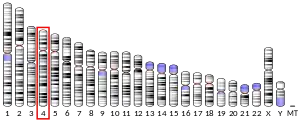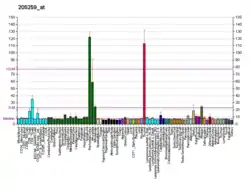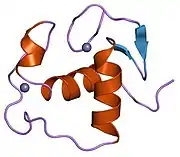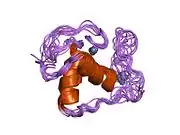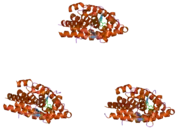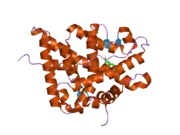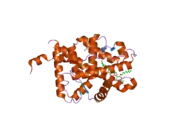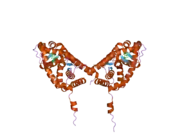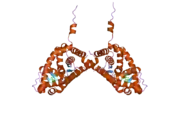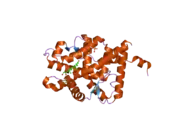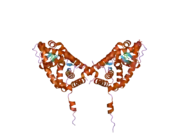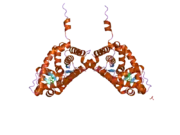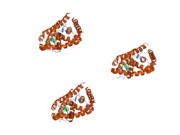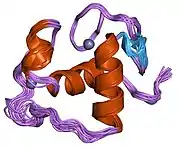| NR3C2 | |||||||||||||||||||||||||||||||||||||||||||||||||||
|---|---|---|---|---|---|---|---|---|---|---|---|---|---|---|---|---|---|---|---|---|---|---|---|---|---|---|---|---|---|---|---|---|---|---|---|---|---|---|---|---|---|---|---|---|---|---|---|---|---|---|---|
 | |||||||||||||||||||||||||||||||||||||||||||||||||||
| |||||||||||||||||||||||||||||||||||||||||||||||||||
| Identifiers | |||||||||||||||||||||||||||||||||||||||||||||||||||
| Aliases | NR3C2, MCR, MLR, MR, NR3C2VIT, nuclear receptor subfamily 3 group C member 2 | ||||||||||||||||||||||||||||||||||||||||||||||||||
| External IDs | OMIM: 600983 MGI: 99459 HomoloGene: 121495 GeneCards: NR3C2 | ||||||||||||||||||||||||||||||||||||||||||||||||||
| |||||||||||||||||||||||||||||||||||||||||||||||||||
| |||||||||||||||||||||||||||||||||||||||||||||||||||
| |||||||||||||||||||||||||||||||||||||||||||||||||||
| |||||||||||||||||||||||||||||||||||||||||||||||||||
| |||||||||||||||||||||||||||||||||||||||||||||||||||
| Wikidata | |||||||||||||||||||||||||||||||||||||||||||||||||||
| |||||||||||||||||||||||||||||||||||||||||||||||||||
The mineralocorticoid receptor (or MR, MLR, MCR), also known as the aldosterone receptor or nuclear receptor subfamily 3, group C, member 2, (NR3C2) is a protein that in humans is encoded by the NR3C2 gene that is located on chromosome 4q31.1-31.2.[5]
MR is a receptor with equal affinity for mineralocorticoids and glucocorticoids. It belongs to the nuclear receptor family where the ligand diffuses into cells, interacts with the receptor and results in a signal transduction affecting specific gene expression in the nucleus. The selective response of some tissues and organs to mineralocorticoids over glucocorticoids occurs because mineralocorticoid-responsive cells express Corticosteroid 11-beta-dehydrogenase isozyme 2, an enzyme which selectively inactivates glucocorticoids more readily than mineralocorticoids.
Function
MR is expressed in many tissues, such as the kidney, colon, heart, central nervous system (hippocampus), brown adipose tissue and sweat glands. In epithelial tissues, its activation leads to the expression of proteins regulating ionic and water transports (mainly the epithelial sodium channel or ENaC, Na+/K+ pump, serum and glucocorticoid induced kinase or SGK1) resulting in the reabsorption of sodium, and as a consequence an increase in extracellular volume, increase in blood pressure, and an excretion of potassium to maintain a normal salt concentration in the body.
The receptor is activated by mineralocorticoids such as aldosterone and its precursor deoxycorticosterone as well as glucocorticoids like cortisol. In intact animals, the mineralocorticoid receptor is "protected" from glucocorticoids by co-localization of an enzyme, corticosteroid 11-beta-dehydrogenase isozyme 2 (a.k.a. 11β-hydroxysteroid dehydrogenase 2; 11β-HSD2), that converts cortisol to inactive cortisone.[6]
Activation of the mineralocorticoid receptor, upon the binding of its ligand aldosterone, results in its translocation to the cell nucleus, homodimerization and binding to hormone response elements present in the promoter of some genes. This results in the complex recruitment of the transcriptional machinery and the transcription into mRNA of the DNA sequence of the activated genes.[7]
An activating mutation in the NR3C2 gene (S810L) results in constitutive activity of the mineralocorticoid receptor, leading to severe early-onset hypertension that is exacerbated by pregnancy. In a family known to harbor the S810L mutation, 3 individuals carrying the mutation died of chronic heart failure before age 50.[8] Additional studies have shown that this activated version of MR can positively respond to ligands that are traditionally antagonists, such as endogenous hormones like progesterone, and the diuretic drugs spironolactone and eplerenone.[8]
Ligands
Aldosterone, 11-deoxycorticosterone, and cortisol are endogenous agonists of the MR. Fludrocortisone is a synthetic agonist of the MR which is used clinically. Progesterone is a potent endogenous antagonist of the MR.[9] Synthetic antagonists of the MR include the steroidal compounds spironolactone, canrenone, eplerenone, and drospirenone and the nonsteroidal compounds apararenone, esaxerenone, and finerenone.
Interactions
Mineralocorticoid receptor has been shown to interact with:
See also
References
- 1 2 3 GRCh38: Ensembl release 89: ENSG00000151623 - Ensembl, May 2017
- 1 2 3 GRCm38: Ensembl release 89: ENSMUSG00000031618 - Ensembl, May 2017
- ↑ "Human PubMed Reference:". National Center for Biotechnology Information, U.S. National Library of Medicine.
- ↑ "Mouse PubMed Reference:". National Center for Biotechnology Information, U.S. National Library of Medicine.
- ↑ Fan YS, Eddy RL, Byers MG, Haley LL, Henry WM, Nowak NJ, Shows TB (1989). "The human mineralocorticoid receptor gene (MLR) is located on chromosome 4 at q31.2". Cytogenetics and Cell Genetics. 52 (1–2): 83–4. doi:10.1159/000132846. PMID 2558856.
- ↑ Edwards CR, Stewart PM, Burt D, Brett L, McIntyre MA, Sutanto WS, et al. (October 1988). "Localisation of 11 beta-hydroxysteroid dehydrogenase--tissue specific protector of the mineralocorticoid receptor". Lancet. 2 (8618): 986–9. doi:10.1016/S0140-6736(88)90742-8. hdl:1874/24458. PMID 2902493. S2CID 206004965.
- ↑ Fuller PJ, Young MJ (December 2005). "Mechanisms of mineralocorticoid action". Hypertension. 46 (6): 1227–35. CiteSeerX 10.1.1.319.6620. doi:10.1161/01.HYP.0000193502.77417.17. PMID 16286565. S2CID 14749847.
- 1 2 Geller DS, Farhi A, Pinkerton N, Fradley M, Moritz M, Spitzer A, et al. (July 2000). "Activating mineralocorticoid receptor mutation in hypertension exacerbated by pregnancy". Science. 289 (5476): 119–23. Bibcode:2000Sci...289..119G. doi:10.1126/science.289.5476.119. PMID 10884226.
- ↑ Baker ME, Katsu Y (July 2020). "Progesterone: An enigmatic ligand for the mineralocorticoid receptor". Biochemical Pharmacology. 177: 113976. arXiv:2001.07822. doi:10.1016/j.bcp.2020.113976. PMID 32305433. S2CID 216028937.
- 1 2 Savory JG, Préfontaine GG, Lamprecht C, Liao M, Walther RF, Lefebvre YA, Haché RJ (February 2001). "Glucocorticoid receptor homodimers and glucocorticoid-mineralocorticoid receptor heterodimers form in the cytoplasm through alternative dimerization interfaces". Molecular and Cellular Biology. 21 (3): 781–93. doi:10.1128/MCB.21.3.781-793.2001. PMC 86670. PMID 11154266.
- ↑ Zennaro MC, Souque A, Viengchareun S, Poisson E, Lombès M (September 2001). "A new human MR splice variant is a ligand-independent transactivator modulating corticosteroid action". Molecular Endocrinology. 15 (9): 1586–98. doi:10.1210/mend.15.9.0689. PMID 11518808.
- ↑ Thénot S, Henriquet C, Rochefort H, Cavaillès V (May 1997). "Differential interaction of nuclear receptors with the putative human transcriptional coactivator hTIF1". The Journal of Biological Chemistry. 272 (18): 12062–8. doi:10.1074/jbc.272.18.12062. PMID 9115274.
Further reading
- Hellal-Levy C, Fagart J, Souque A, Rafestin-Oblin ME (April 2000). "Mechanistic aspects of mineralocorticoid receptor activation". Kidney International. 57 (4): 1250–5. doi:10.1046/j.1523-1755.2000.00958.x. PMID 10760050.
- Sheppard KE (May 2002). "Nuclear receptors. II. Intestinal corticosteroid receptors". American Journal of Physiology. Gastrointestinal and Liver Physiology. 282 (5): G742-6. doi:10.1152/ajpgi.00531.2001. PMID 11960770.
- Kjellander CG (March 1975). "[The psychotherapeutic society--utopia or nightmare?]". Läkartidningen. 72 (12): 1160–1. PMID 1134129.
- Alnemri ES, Maksymowych AB, Robertson NM, Litwack G (September 1991). "Overexpression and characterization of the human mineralocorticoid receptor". The Journal of Biological Chemistry. 266 (27): 18072–81. doi:10.1016/S0021-9258(18)55238-8. PMID 1655735.
- Morrison N, Harrap SB, Arriza JL, Boyd E, Connor JM (June 1990). "Regional chromosomal assignment of the human mineralocorticoid receptor gene to 4q31.1". Human Genetics. 85 (1): 130–2. doi:10.1007/BF00276340. PMID 2162806. S2CID 9264993.
- Fan YS, Eddy RL, Byers MG, Haley LL, Henry WM, Nowak NJ, Shows TB (1989). "The human mineralocorticoid receptor gene (MLR) is located on chromosome 4 at q31.2". Cytogenetics and Cell Genetics. 52 (1–2): 83–4. doi:10.1159/000132846. PMID 2558856.
- Arriza JL, Weinberger C, Cerelli G, Glaser TM, Handelin BL, Housman DE, Evans RM (July 1987). "Cloning of human mineralocorticoid receptor complementary DNA: structural and functional kinship with the glucocorticoid receptor". Science. 237 (4812): 268–75. Bibcode:1987Sci...237..268A. doi:10.1126/science.3037703. PMID 3037703.
- Bloem LJ, Guo C, Pratt JH (November 1995). "Identification of a splice variant of the rat and human mineralocorticoid receptor genes". The Journal of Steroid Biochemistry and Molecular Biology. 55 (2): 159–62. doi:10.1016/0960-0760(95)00162-S. PMID 7495694. S2CID 10179119.
- Jalaguier S, Mornet D, Mesnier D, Léger JJ, Auzou G (April 1996). "Human mineralocorticoid receptor interacts with actin under mineralocorticoid ligand modulation". FEBS Letters. 384 (2): 112–6. doi:10.1016/0014-5793(96)00295-5. PMID 8612804. S2CID 34685894.
- Thénot S, Henriquet C, Rochefort H, Cavaillès V (May 1997). "Differential interaction of nuclear receptors with the putative human transcriptional coactivator hTIF1". The Journal of Biological Chemistry. 272 (18): 12062–8. doi:10.1074/jbc.272.18.12062. PMID 9115274.
- Zennaro MC, Farman N, Bonvalet JP, Lombès M (May 1997). "Tissue-specific expression of alpha and beta messenger ribonucleic acid isoforms of the human mineralocorticoid receptor in normal and pathological states". The Journal of Clinical Endocrinology and Metabolism. 82 (5): 1345–52. doi:10.1210/jcem.82.5.3933. PMID 9141514.
- Bruner KL, Derfoul A, Robertson NM, Guerriero G, Fernandes-Alnemri T, Alnemri ES, Litwack G (1997). "The unliganded mineralocorticoid receptor is associated with heat shock proteins 70 and 90 and the immunophilin FKBP-52". Receptors & Signal Transduction. 7 (2): 85–98. PMID 9392437.
- Geller DS, Rodriguez-Soriano J, Vallo Boado A, Schifter S, Bayer M, Chang SS, Lifton RP (July 1998). "Mutations in the mineralocorticoid receptor gene cause autosomal dominant pseudohypoaldosteronism type I". Nature Genetics. 19 (3): 279–81. doi:10.1038/966. PMID 9662404. S2CID 33028408.
- Lupo B, Mesnier D, Auzou G (September 1998). "Cysteines 849 and 942 of human mineralocorticoid receptor are crucial for steroid binding". Biochemistry. 37 (35): 12153–9. doi:10.1021/bi980593e. PMID 9724527.
- Halushka MK, Fan JB, Bentley K, Hsie L, Shen N, Weder A, et al. (July 1999). "Patterns of single-nucleotide polymorphisms in candidate genes for blood-pressure homeostasis". Nature Genetics. 22 (3): 239–47. doi:10.1038/10297. PMID 10391210. S2CID 4636523.
- Freeman BC, Felts SJ, Toft DO, Yamamoto KR (February 2000). "The p23 molecular chaperones act at a late step in intracellular receptor action to differentially affect ligand efficacies". Genes & Development. 14 (4): 422–34. doi:10.1101/gad.14.4.422. PMC 316379. PMID 10691735.
- Geller DS, Farhi A, Pinkerton N, Fradley M, Moritz M, Spitzer A, et al. (July 2000). "Activating mineralocorticoid receptor mutation in hypertension exacerbated by pregnancy". Science. 289 (5476): 119–23. Bibcode:2000Sci...289..119G. doi:10.1126/science.289.5476.119. PMID 10884226.
- Hellal-Levy C, Fagart J, Souque A, Wurtz JM, Moras D, Rafestin-Oblin ME (August 2000). "Crucial role of the H11-H12 loop in stabilizing the active conformation of the human mineralocorticoid receptor". Molecular Endocrinology. 14 (8): 1210–21. doi:10.1210/mend.14.8.0502. PMID 10935545.
- Watzka M, Beyenburg S, Blümcke I, Elger CE, Bidlingmaier F, Stoffel-Wagner B (August 2000). "Expression of mineralocorticoid and glucocorticoid receptor mRNA in the human hippocampus". Neuroscience Letters. 290 (2): 121–4. doi:10.1016/S0304-3940(00)01325-2. PMID 10936692. S2CID 45158226.
External links
- Mineralocorticoid+Receptors at the U.S. National Library of Medicine Medical Subject Headings (MeSH)
